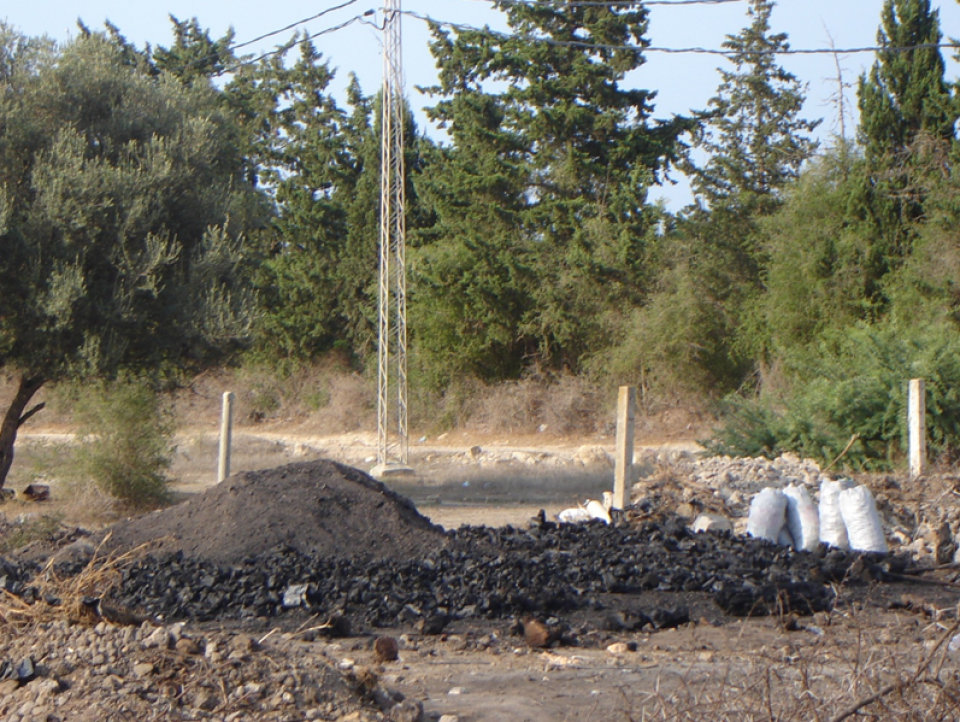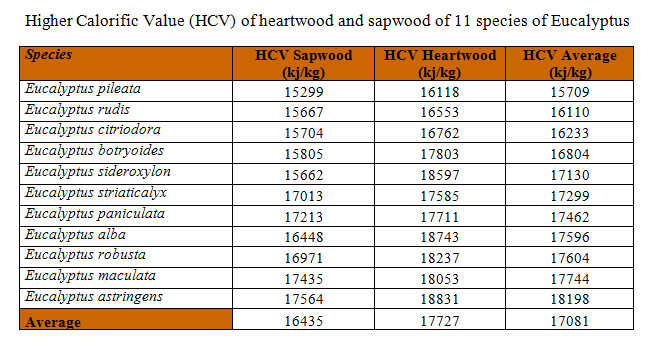
In rural areas of Tunisia, the average wood consumption per household and per year is between 1.8 and 5.9 tones. The highest consumption was noted in the forest regions of Sejnane, Boussalem and Jendouba. Results show that traditional bread baking represents 60 to 70% of the percentage of wood consumed in households. With a view to satisfying the increasingly growing needs for firewood and charcoal in rural areas, we have initiated a selection research program oriented towards more intensive wood production including wood that can be used for energy purposes. In this work, we propose to compare the energy performance of 11 species of Eucalyptus.
The biomass produced by the Eucalyptus trees is used in the bioenergy field. The experimental material consists of wood taken from 11 species of Eucalyptus planted in the arboretum of Choucha. These species are E citriodora, E maculata, E paniculata, E astringens, E pileata, E robusta, E striaticalyx, E botryoides, E alba, E rudis and E sideroxylon. To evaluate the energy performances of the studied species, various parameters were selected: the higher calorific value (HCV), the degree of humidity and the basal density of the wood, the rates of gases released during combustion.
There is an important variability among different woods from an energy point of view. The values of the quantitative and qualitative parameters studied have shown that the higher calorific value (HCV) varies from 15299 to 17564 kJ / kg for sapwood and from 16118 to 1883 kJ / kg for heartwood (Table). As for the ignition temperature, it ranges from 256 to 296 °C for sapwood and from 268 to 308 °C for heartwood. Then regarding the temperature of the hearth in combustion, it goes from 446 to 528 ° C depending on the type of wood and the percentage of ash is between 2.6 and 20%. And apropos of the gases released from the combustion of wood (CO2 and CO), the rates range from 4 to 7.5% for CO2 and from 0.5 to 2% for CO.
A notable difference of the energetic yield was perceived between the species of Eucalyptus tested. In practice, it leads to the possibility of making a selection for the benefit of the best performing species. Therefore Eucalyptus astringens, Eucalyptus maculata et Eucalyptus robusta, which not only offer a good biomass production, but also a good quality of combustible products (fuelwood and charcoal). Consequently, such species can be selected for intensive reforestation purpose especially oriented towards an energy objective, preferably conducted in short rotation (6-7 years in good edapho-climatic conditions).
The demographic changes and the overexploitation of forest resources, which supplied wood, spawned a strong imbalance between consumption and availability of raw materials. The situation was considered critical, which required a quick solution. The use of the most performing eucalyptus (from the point of view of biomass production and energy yield) is a solution to satisfy the increasingly growing needs in fuelwood or charcoal.
An effort should be made by researchers and forest technicians to vulgarize research results concerning the choice of bioenergetic eucalyptus species, ensure their production in nurseries and their planting, especially in available land similarly in rural and suburban areas. Raising awareness among GDAs and involving them directly in this effort is an asset in guaranteeing the success of plantations and ensuring their direct management by the beneficiary populations.
Mohamed Larbi Khouja : khouja.larbi15@gmail.com, www.inrgref.agrinet.tn
Elaieb Mohamed Taher: ayeb2002@yahoo.fr, www.inrgref.agrinet.tn
Ibtissem Taghouti : ibtissem.taghouti@gmail.com, www.inrgref.agrinet.tn
Amor Mlaouhi : mlaouhi.amor@iresa.agrinet.tn
Further information
Mlaouhi A., Mlaouhi S. et Depeyre D., 1999 – Evolution de la consommation de bois de feu en Tunisie au cours de la période 1997 – 2030, Revue de l’INAT , vol 14 N° 2, 41 –56.
Mlaouhi A., Mazghouni M., Kharroubi H., Hssaïri M., Khouaja A., et Depeyre D., 2002 – Etude des caractéristiques énergétiques et environnementales du bois de quelques espèces forestières tunisiennes. Ann. de l’INRGREF, 5, 165-175.
Mlaouhi A., Khouja ML., Mazghouni M., Kharroubi H., Toumi L. et Depeyre D., 2004 – Etude des performances de six types de combustible dans le système de cuisson de pain traditionnel en Tunisie (Tabouna). Ann. de l’INRGREF, 6, 127-139.
Mlaouhi A., Khouja M.L., Mazghouni M.., Kharroubi H., Toumi L. et Depeyre D., 2005 - Estimation de la consommation énergétique en combustible ligneux des ménages ruraux dans les régions du nord de la Tunisie ; Annales de l’INRGREF, 7, Numéro spécial, 167-176.
Rezgui M., 2003 - Evaluation énergétique du combustible en milieu rurale en Tunisie. Mémoire de fin d’études de l’ISP Tabarka, 61p.
Mohamed Larbi Khouja

Mohamed Larbi Khouja
